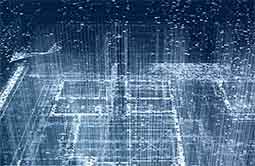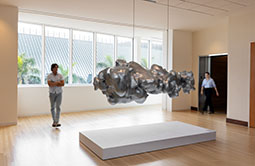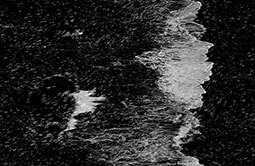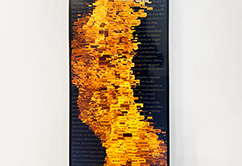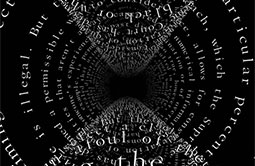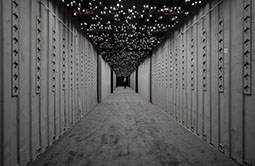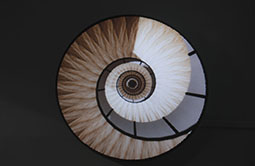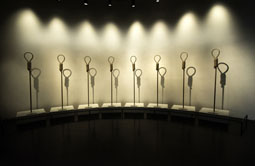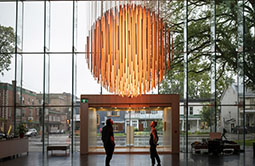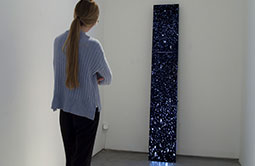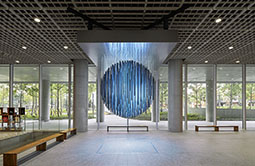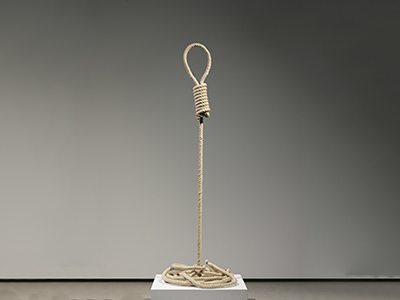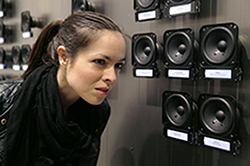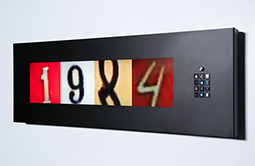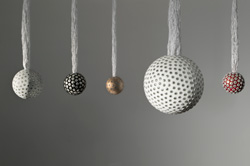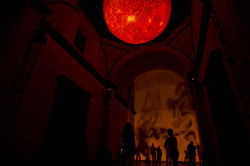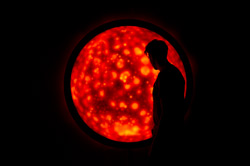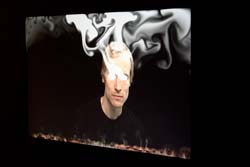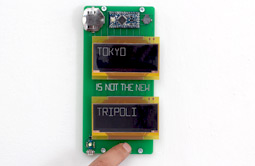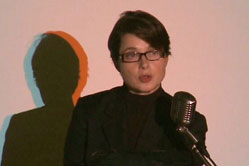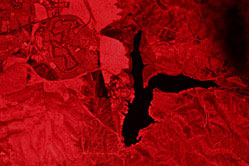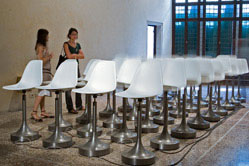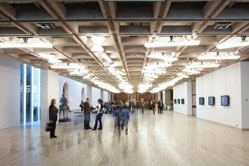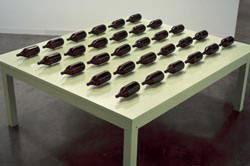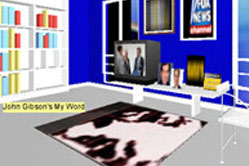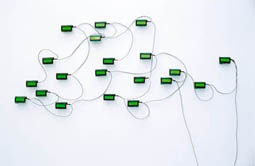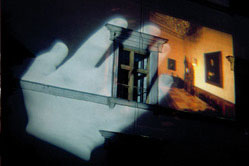Recurrent Lloyd Wright
2024
“Recurrent Lloyd Wright” is a recursive algorithmic animation that draws together the vast corpus of Frank Lloyd Wright’s “Usonian” architectural blueprints and evaporates them into a fluid atmosphere. In this piece, the modernist utopian vision of Lloyd Wright’s designs drift back and forth, and are endlessly remade. The sense of context and materials at the core of the architect’s poetics is dissolved into a virtual and speculative existence. In rendering atmospheric Lloyd Wright’s grounded design, “Recurrent Lloyd Wright” is, at once, a commentary on the fate of modernism and a blueprint to imagine future, possible architectonics. This artwork is available as both a treatment and a standalone piece.
View details.
View details.
Volute 2: Listen to the World
2023
In the "Volute" series —words, phrases, and songs—are rendered into turbulent clouds containing layers of complex folds and vortices, with a method developed by Lozano-Hemmer's studio in conjunction with fluid dynamic scientists from Georgia Institute of Technology, Auburn University, and NYU. A custom-made laser tomograph scans the breath exhaled while spoken, then converts it into a 3D shape using photogrammetry.
View details.
View details.
Hormonium
Text Stream 8, 2022
“Hormonium” (Text Stream 8) is a generative artwork that presents sequences of ocean waves crashing and releasing airborne text particles, with the text representing acronyms of hormones that are released in accordance with human time-cycles. This artwork is available as both a projection and a standalone piece.
View details.
View details.
Recurrent First Dream
Text Stream 10, 2022
“Recurrent First Dream” (Primero Sueño Recurrente) is a recursive algorithmic animation made with the collected works of Mexican poet Sor Juana Inés de la Cruz. An ascending vortex of words routinely appears and scans the displays, slowly revealing the poet’s mangum opus “First Dream”, a pioneering feminist ode to knowledge and deductive reasoning, written in 1692.
View details.
View details.
Field Atmosphonia
2020
“Field Atmosphonia” is a sound and light environment featuring 3,000 audio channels playing on custom-made speakers with LED lights. The project is a soundscape that comes in waves of complex polyphonies that emerge from the array of field recordings.
View details.
View details.
Recurrent Rayuela
Text Stream 6, 2020
"Recurrent Rayuela" (Text Stream 6) is a generative artwork made with the 155 chapters of the experimental novel "Rayuela" (Hopscotch) published in 1963 by Argentine writer Julio Cortázar. The piece consists of a black circular screen that shows a cube with thousands of letters from the book in a fluid, animated pool. When the screen is manually rotated by a visitor, the cube tumbles around and the letters become turbulent; after a few seconds, random excerpts from the novel emerge on screen from the turbulence. As soon as the rotation ends the excerpts disappear and the pool of letters stabilizes again.
View details.
View details.
Recurrent Llull
Text Stream 7, 2019
“Recurrent Llull” (Text Stream 7) is a recursive algorithmic animation made with the collected works of Mediterranean philosopher and polymath Ramon Llull, born in the kingdom of Majorca in 1232. Among Llull’s accomplishments was the very first symbolic machine, a series of concentric circles that could be operated to generate combinations of “elemental truths”.
View details.
View details.
Cloud Display
2019
“Cloud Display” is a vertical water fountain consisting of 1,600 ultrasonic atomizers, controlled by a machine-learning voice recognition system. When a participant speaks into an intercom, the piece writes any words or sentences spoken using wisps of pure water vapour. The project can work in most languages, and recognizes different accents.
View details.
View details.
Linear Atmosphonia
2019
“Linear Atmosphonia” is a sound environment featuring 3,000 audio channels playing on separate custom-made speakers with LED lights. The piece can be presented as a tunnel or room, and the recordings change typology gradually along the field of speakers: recordings include wind, water, fire, ice, over 200 types of insects, over 300 types of birds, bells, metronomes, bombs and so on. The project results in waves of complex polyphonies that emerge from the array of field recordings.
View details.
View details.
Babbage Lovelace
Text Stream 5, 2019
“Babbage Lovelace” (Text Stream 5) is a generative animation based on the collected texts of Charles Babbage and Ada Lovelace turned into a stream of letters.
View details.
View details.
Descending a Parametric Staircase
2018
This piece is a generative animation showing a descent into a never-ending spiral staircase. From time to time, uncanny virtual naked people can be seen walking down the staircase. The work never repeats the same sequence of characters. “Descending a Parametric Staircase” is a homage to Duchamp’s futurist composite “Nude Descending a Staircase” from 1912, taking its colour palette, and his “Rotoreliefs” from 1935.
View details.
View details.
Metrónomos
2018
“Metrónomos” is a kinetic installation consisting of eight inverted nooses, which move slightly according to the rhythm of various global statistics on human rights violations. Commissioned for Mexico’s Memory and Tolerance Museum, the sculptures are presented on pedestals, arranged in a semi-circle. The frequency in which each noose, or metronome, sways depends on the statistic that each one represents: the number of forced displacements or deportations, acts of torture, cruelty and sexual violence, crimes against the environment, among others. Each noose contains the heartbreaking rhythm of a different scale, in order to materialize, symbolically, the frequency in which human rights are violated. Together, they create a chorus of sculptures activated by statistical data.
View details.
View details.
Volumetric Solar Equation
2018
“Volumetric Solar Equation” is a large-scale spherical volumetric display that simulates the varying turbulences, flares, and spots visible on the surface of the sun. Animated by mathematical equations and the latest imagery from NASA’s solar observatories, the content is dynamic and ever-changing, based on live rather than looped video simulations. The chandelier is three metres in diameter and made of 25,580 LED lights on 342 battens.
View details.
View details.
Recurrent Sanches
Text Stream 3, 2018
“Recurrent Sanches” (Text Stream 3) is a new algorithmic text spring made with the works of Spanish-Portuguese philosopher and physician Francisco Sanches, most notably his sceptical treatise “That nothing can be known” Quod nihil scitur (1581) in which he proposes that nothing can be known through its causes, since it would also be necessary to know the causes of the causes, and then their causes, in an infinite regress.
View details.
View details.
Sphere Packing: Bach
2018
A 3m diameter sphere that supports 1,128 loudspeakers each of which plays a different composition by Johann Sebastian Bach. The piece is designed to concentrate Bach’s entire musical production in a dense multi-channel structure that visitors can enter. At any given point, all compositions play-back simultaneously creating a polyvocal and complex sound environment focused in the centre of the sphere; from time to time the speakers are gradually silenced in waves to highlight one speaker playing a single composition.
View details.
View details.
Blue Sun
2018
Blue Sun is a spherical chandelier that represents the turbulence, flares, and spots visible on the surface of the sun using the hottest colours in the spectrum: blue and white. Animated by mathematical equations and the latest imagery from NASA’s solar observatories, the content is dynamic and ever-changing, based on live rather than looped video simulations. The piece draws equal inspiration from scientific visualization and traditions of geometric abstraction in contemporary art.
View details.
View details.
Pareidolium
2018
“Pareidolium” is a circular fountain that creates portraits of onlookers in mid-air with clouds of vapor that ascend from the water basin. As a visitor looks into the water, a facial-detection system extracts their image and creates an ephemeral likeness in cold vapour. The portrait becomes tangible, almost breathable, only briefly, then disappears in turbulence.
View details.
View details.
Volute
2016
In the "Volute" series —words, phrases, and songs—are rendered into turbulent clouds containing layers of complex folds and vortices, with a method developed by Lozano-Hemmer's studio in conjunction with fluid dynamic scientists from Georgia Institute of Technology, Auburn University, and NYU. A custom-made laser tomograph scans the breath exhaled while spoken, then converts it into a 3D shape using photogrammetry.
View details.
View details.
Call on Water
2016
Call on Water is a fountain that writes words in mid-air with plumes of cold vapour that ascend from a water basin. Dozens of poems by Mexican writer Octavio Paz are presented which describe readable air, the moment when the written word is spoken and becomes the atmosphere itself. The poems’ content becomes tangible briefly, almost breathable, then disappears in turbulence.
View details.
View details.
Sway
2016
"Sway" is a kinetic sculpture that responds to data; it is a computer-controlled metronome that oscillates to the rhythm of a specific statistic. The rope was braided onto a thin vertical carbon fiber rod to make it stand upright and the floor rope acts as a free-standing base. The piece stands on a wooden plinth which contains a small motor and an electrical circuit that makes the noose sway and pendulate almost imperceptibly from time to time. The sway adds to the trompe l’oeil effect of the rope hanging upside-down. The collector or curator may choose the frequency with which the rope sways, with the default value being around once every 40 to 60 seconds, which represents therate of homicides in the World.
View details.
View details.
Babbage Nanopamphlets
2015
Two million pamphlets were printed in elemental gold, higher in purity than 24-karat gold, using nanotechnology techniques. Around 250,000 copies were released in the exhibition room so they remain floating around in the air, potentially inhaled by the public. These pamphlets are 150 atoms thick and are biologically inert so pose no health risk. The rest of the pamphlets are shown suspended in water together with images taken by an electron microscope. The text engraved onto the gold leaflets is an excerpt from the Ninth Bridgewater Treatise (1837) by Charles Babbage. The text posits that the atmosphere is a vast repository of everything that has ever been said and that we could potentially "rewind" the movement of every molecule of air to recreate the voices of everyone who has spoken in the past.
View details.
View details.
Pan-Anthem
Subsculpture 16, 2014
"Pan-Anthem" (Subsculpture 16) is an interactive sound installation where the national anthem of every country in the World plays back on a movable speaker that is magnetically attached to a large wall. The speakers are precisely arranged to visualize national statistics: population, GDP, area, number of women in parliament, GINI, year of independence, HDI and so on.
For example, when the work is configured to show military spending per capita, on the far left of the wall the public can hear the anthems of countries without military forces like Costa Rica, Iceland and Andorra while at the far right they can hear Saudi Arabia, Israel and the United States, which spend more than $2,000 per person per year. If no one is in the exhibition room all the speakers are silent, but as a visitor approaches a particular set of speakers these start playing automatically, creating a positional panoramic playback of anthems associated to similar statistics.
View details.
View details.
Method Random
2014
"Method Random" is a series of chromogenic prints generated by computational methods attempting to create randomness. Random number generators(RNG) are essential algorithms for a large number of applications, from encryption and security to simulation, jury selection, double-blind trials, statistical sampling, game theory and many others. While the sum of all colours picked by different RNG algorithms generates a neutral gray, a pattern can be discerned when a massive number of pixels can be seen simultaneously. These prints show how human perception of an organization can often spot the fundamental difficulty for computers to appear unpredictable.
View details.
View details.
Nineteen Eighty-Four
2014
"Nineteen Eighty-Four" is an interactive display that shows house address numbers extracted from Google Street View images. The display writes over 22 billion different combinations of the number 1984, which change at a user-specified speed. Typing any number onto an onboard keyboard starts a count-down or count-up until eventually the number 1984 is reached.
View details.
View details.
Sphere Packing
Subsculpture 15, 2013
"Sphere Packing" (Subsculpture 15) is a series of 3D-printed pieces designed to concentrate the entire musical production of a composer in a single dense multi-channel device. The size of each sphere is directly proportional to how prolific the composer was; for example the sphere for Hildegaard Von Bingen has an 11 cm diameter and 69 loudspeakers. The project presents at a glance the comparative production volume of many composers. As people are a couple of metres away from a sphere, they hear a quiet murmur of sounds, but as they approach and put their ears up close to individual speakers, they can hone in on specific compositions.
View details.
View details.
Airborne Newscasts
Relational Architecture 20, 2013
"Airborne Newscasts" (Relational Architecture 20) is an interactive installation originally commissioned by the Chrysler Museum of Art to transform Norfolk, Virginia’s public space into a poetic shadow play. By blocking the light of two projectors, participants cast their shadows onto a 900-square-metre wall, and these shadows are tracked by computerized surveillance systems. Out of the shadows emanate billowing smoke which is mapped onto the wall, slowly accumulating within it. Turbulent clouds of live newscasts evaporate from the “heat” of the tracked bodies.
View details.
View details.
Nave Solar
2011
“Nave Solar” is an interactive installation featuring a fake Sun that is activated by the pendular motion of the public as they hang from a rope and swing along the nave of a 16th Century catholic inquisition church. Using tracking systems, the installation detects the motion of participants and generates smoke that accumulates on the ceiling of the apse as well as activates the Sun's flares, surface turbulence and sun spots.
View details.
View details.
Flatsun
2011
“Flatsun” is a circular display that simulates the turbulence at the surface of the Sun using mathematical equations. The piece reacts to the presence of the public by varying the speed and type of animation displayed. If no one is in front of the piece the turbulence slows down and eventually turns off. As the built-in camera detects people, more solar flares are generated and the fake Sun shows more perturbation and activity. At 140 cm diameter, “Flatsun” is exactly a billion times smaller than the real Sun.
View details.
View details.
The Year's Midnight
Shadow Box 5, 2011
"The Year's Midnight" is an interactive installation that shows the viewers' image on screen, unprocessed, except for plumes of white or black smoke that emanate from their eye sockets until the whole display is filled with a dense smog. Live and recorded eyeballs extracted from the video accumulate on the bottom of the display, similar to traditional representations of St. Lucy. The project's name is the beginning of John Donne's "A Nocturnal Upon St. Lucy's Day, Being the Shortest Day", a mournful poem which inspires this work.
View details.
View details.
X is not the new Y
2011
“X is not the new Y” is a small format artwork where over 500,000 combinations of proper names, companies and cities are presented as random inequalities by two electronic paper displays.
View details.
View details.
Solar Equation
Relational Architecture 16, 2010
"Solar Equation" is a large-scale public art installation that consists of a faithful simulation of the Sun, 100 million times smaller than the real thing. Commissioned by the Light in Winter Festival in Melbourne, the piece features the world’s largest spherical balloon, custom-manufactured for the project, which is tethered over Federation Square and animated using five projectors. The solar animation on the balloon is generated by live mathematical equations that simulate the turbulence, flares and sunspots that can be seen on the surface of the Sun. This produces a constantly changing display that never repeats itself, giving viewers a glimpse of the majestic phenomena that are observable at the solar surface and that only relatively recent advances in astronomy have discovered. Using an iPhone, iPod touch or iPad, people may disturb the animations in real-time and select different fluid dynamic visualizations.
View details.
View details.
Levels of Nothingness
Performers 1, 2009
"Levels of Nothingness" is an installation-performance commissioned for the 50th Anniversary of the Guggenheim Museum, inspired by Kandinsky's opera, "The Yellow Sound" (1912). In "Levels of Nothingness", the human voice is analyzed by computers, automatically controlling a full rig of Rock-and-Roll concert lighting and creating an interactive colour show. For the New York performances, Isabella Rossellini read a libretto co-written by Brian Massumi, which included seminal philosophical texts on skepticism, color and perception, including writings by Kandinsky, Deleuze, Sanches, Simon Baron-Cohen and Alexander Luria. Following the performances, audience members could test the color-generating microphone.
View details.
View details.
Navier-Stokes
2009
"Navier-Stokes" is a series of computer-controlled lightboxes that show satellite pictures of border regions that have a vector of economic disparity, a history of military conflict or heavy migratory traffic. Instead of using regular white fluorescent light tubes to illuminate the print, the pieces have over one hundred thousand light emitting diodes (LEDs), which can highlight tiny features within the image. The first piece shows the Tijuana-San Diego border with Mexico illuminated red by default while the US is dark.
View details.
View details.
Seismoscopes
2009
The series "Seismoscopes" consists of devices that detect vibration around them, from footsteps to earthquakes, and record this vibration on paper using an automated XY-plotter. As each Seismoscope registers any seismic wave it is programmed to draw an illustration of a single Skeptical philosopher, over and over again.
View details.
View details.
Wavefunction
Subsculpture 9, 2007
"Wavefunction" (Subsculpture 9) is a kinetic sculpture comprised of fifty to one hundred Charles and Ray Eames moulded chairs (designed in 1948) and placed in a regular array of rows, facing the entrance to the exhibition space. When someone approaches the work, a computerised surveillance system detects their presence and the closest chairs automatically begin to lift off the ground, creating the crest of a wave that then spreads over the whole room.
View details.
View details.
Homographies
Subsculpture 7, 2006
"Homographies" (Subsculpture 7) is a large-scale interactive installation featuring a turbulent light array that responds to the movement of the public using a surveillance tracking system. The installation consists of white fluorescent light tubes hung from robotic fixtures on the ceiling of the exhibition space, equally spaced. Each light tube rotates slowly using a computerized stepper motor and create labyrinthine patterns of light that make "paths" or "corridors" between people. All lights are always on and typically constitute the only lighting in the exhibition hall, except for the natural light that spills into the space.
View details.
View details.
Synaptic Caguamas
Subsculpture 4, 2004
"Synaptic Caguamas" (Subsculpture 4) is a kinetic sculpture consisting of a motorized Mexican "cantina" bar table with 30 "Caguama"-sized beer bottles (1-litre each). The bottles spin on the table with patterns generated by cellular automata algorithms that simulate the neuronal connections in the brain. Every few minutes the bottles are reset automatically and seeded with new initial conditions for the algorithm, so that the movement patterns are never repeated.
View details.
View details.
Sitestepper
Relational Architecture 10, 2004
"Sitestepper" (Relational Architecture 10) is an Internet program that shows a 3D view of an apparently "neutral" living room. This space can be transformed automatically by scanning a website to extract its images, texts, colours and sounds. The system analyzes the contents of the submitted webpage and uses them to furnish and decorate the room, "branding" the space with a layer of live media. This project was commissioned for LA MOCA's digital gallery.
View details.
View details.
Standards and Double Standards
Subsculpture 3, 2004
"Standards and Double Standards" (Subsculpture 3) is an interactive installation that consists of 10 to 100 fastened belts that are suspended at waist height from stepper motors on the ceiling of the exhibition room. Controlled by a computerized tracking system, the belts rotate automatically to follow the public, turning their buckles slowly to face passers-by. When several people are in the room their presence affects the entire group of belts, creating chaotic patterns of interference. Non-linear behaviours emerge such as turbulence, eddies and relatively quiet regions.
View details.
View details.
33 Questions per Minute
Relational Architecture 5, 2000
"33 Questions Per Minute" (Relational Architecture 5) consists of a computer program which uses grammatical rules to combine words from a dictionary and generate 4.7 trillion unique, fortuitous questions. The automated questions are presented at a rate of 33 per minute—the threshold of legibility. The system will take over 271,000 years to ask all possible questions.
View details.
View details.
Displaced Emperors
Relational Architecture 2, 1997
"Displaced Emperors" (Relational Architecture 2) was an interactive installation that used an "architact" —architecture meets haptics— interface to transform the facade of the Habsburg Castle in Linz, Austria. Wireless 3D sensors calculated where participants pointed to on the façade and a large animated projection of a hand was projected at that location. As people on the street "caressed" the building, they could reveal the interiors of the Habsburg residence in Mexico City, Castillo de Chapultepec.
View details.
View details.
